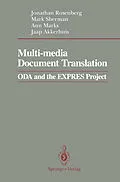As part of the NSF's EXPRES project, the authors investigated ways to interchange multi-media documents among diverse systems. Their investigations led to an analysis and implementation of multi-media document format translation in general, and of the ODA standard in particular. ODA, Office Document Architecture, is a new ISO and CCITT international standard for representing multi- media documents. The results of their investigations are presented in this book. The book contains overview information about multi-media document architecture and formats, an introduction to ODA, detailed technical specifications on how to use ODA for multi-media document format translation, and the authors' experiences in implementing and using ODA. The book also contains a complete user manual for the authors' publically available ODA software: tool kits for manipulating ODA and raster formats, tools for examining ODA documents and sample translators between ODA and several other multi-media formats. This book provides comprehensive information about ODA for a large audience. Planners can get basic information about using ODA for interoperation of multi-media systems. Researchers receive detailed discussions about the advantages and problems of using ODA for document representation, format translation and archival storage. System designers can use the technical descriptions of translators and tools in specifying their own. System builders can easily obtain the software as a basis for prototyping and investigating their own ODA implementations.
Inhalt
1. ODA and Document Interchange.- 1. Introduction.- 1.1. The EXPRES Project.- 1.1.1. The EXPRES Participants.- 1.1.2. Proposal Submission.- 1.1.3. Scientific Document Interchange.- 1.2. Multi-media Document Interchange.- 1.2.1. Choice of an Intermediate Representation.- 1.2.1.1. Candidates for an Intermediate Representation.- 1.2.2. Document Interchange Goals.- 1.3. Notational Conventions for this Book.- 1.4. Organization of this Book.- 1.4.1. Overall Organization.- 1.4.2. Part 1: Introduction to ODA and Document Interchange.- 1.4.3. Part 2: Introduction to the Tool Kits.- 1.4.4. Part 3: The CMU ODA Tool Kit.- 1.4.5. Part 4: The Raster Graphics Tool Kit.- 1.4.6. Part 5: References and Appendixes.- 2. Document Models and Interchange Fidelity.- 2.1. Parts of a Document Model.- 2.1.1. Document Organization.- 2.1.2. Document Content.- 2.1.3. Document Presentation.- 2.1.3.1. Content Formatting.- 2.1.3.2. Page Layout.- 2.1.3.3. Relationships among Document Pieces and Formatting.- 2.2. Document Editing.- 2.2.1. Manipulating Document Organization.- 2.2.1.1. Naming Structures.- 2.2.1.2. Constraining Structure.- 2.2.1.3. Constraining the Constraint.- 2.2.2. Manipulating Document Content.- 2.2.3. Manipulating Formatting Information.- 2.2.3.1. Embedded Commands.- 2.2.3.2. Direct Manipulation.- 2.2.3.3. Named Manipulation.- 2.2.3.4. Style Systems.- 2.3. Translating Documents.- 2.3.1. Imaging Fidelity.- 2.3.2. Content Fidelity.- 2.3.3. Structural Fidelity.- 2.3.4. Editing Fidelity.- 3. Introduction to the Office Document Architecture.- 3.1. Informal Introduction to the ODA Document Structures.- 3.1.1. Introduction to the ODA Document Structures.- 3.1.2. Logical and Layout Structures.- 3.1.3. Specific and Generic Structures.- 3.1.4. The Layout Process.- 3.1.4.1. An Example of Document Layout.- 3.1.4.2. Positioning of Blocks within Frames.- 3.1.4.3. Changing the Layout.- 3.2. ODA Document Architecture and Processing Model.- 3.2.1. The Document Profile.- 3.2.1.1. Presence of Document Constituents.- 3.2.1.2. Document Characteristics.- 3.2.1.3. Document Management Attributes.- 3.2.2. ODA Document Processing Model.- 3.2.3. The Imaging Process.- 3.2.4. Document Architecture Classes.- 3.2.5. Attribute Values.- 3.2.5.1. String Expressions.- 3.2.5.2. Numeric Expressions.- 3.2.5.3. Object Identifier Expressions.- 3.2.6. Default Attribute Values.- 3.3. ODA Content Architectures.- 3.3.1. Character Content.- 3.3.2. Raster Graphics Content.- 3.3.3. Geometric Graphics Content.- 3.4. Document Application Profiles.- 3.5. ODA and Other Standards.- 3.5.1. Relationship with CCITT Recommendations.- 3.5.2. Use of ASN.1.- 3.5.3. Relationship with SGML.- 4. Document Translation Using ODA.- 4.1. Motivating Another Document Model for EXPRES.- 4.2. Document Model Notation.- 4.3. Available Content.- 4.3.1. Predefined Content Architectures.- 4.3.2. Additional Content Architectures.- 4.4. Document Organization.- 4.4.1. Subsetting the NIST Document Application Profile.- 4.4.2. Mapping Document Organization to ODA.- 4.4.3. Interpreting Generic Logical Structure.- 4.4.3.1. Building the Generic Logical Structure.- 4.5. ODA Structures for Styles and Environments.- 4.5.1. Use of Default Value Lists.- 4.5.2. Adding Constituents for Representing Document Styles.- 4.6. General Page Layout.- 4.7. Generic Layout Structures for General Page Layout.- 4.8. Formatting State Vector.- 4.9. ODA Attribute Values for Styles and Environments.- 4.9.1. General Mapping of Formatting State Vector to ODA.- 4.9.1.1. Attribute Representations.- 4.9.1.2. Generic Layout Representations.- 4.9.2. Diagrams of Attributes.- 4.9.3. Distinguishing Style and Environment Information.- 4.9.4. Left Margin, Right Margin and Paragraph Indentation.- 4.9.4.1. Left Margin and Paragraph Indentation.- 4.9.4.2. Right Margin.- 4.9.4.3. Examples of Changed Margins.- 4.9.5. Paragraph Spread.- 4.9.6. Paragraph Breaks.- 4.9.7. Font Manipulations.- 4.9.8. Content Alignment (Justification).- 4.9.9. Line Spacing.- 4.9.10. Tab Stops.- 4.9.11. Page Breaks.- 4.9.12. Representation of Page Layout Components.- 4.9.12.1. Design and Insertion of a New Page.- 4.9.12.2. Top and Bottom Margins.- 4.9.12.3. Headers and Footers.- 4.9.12.4. Page Numbers.- 4.10. Document Profile.- 4.11. Review.- 5. Experience using ODA.- 5.1. EXPRES Document Systems.- 5.1.1. The Andrew Toolkit (ATK).- 5.1.1.1. Document Model.- 5.1.1.2. Translator Implementation.- 5.1.2. Diamond.- 5.1.2.1. Document Model.- 5.1.2.2. Translator Implementation.- 5.1.3. Interleaf.- 5.1.3.1. Document Model.- 5.1.3.2. Translator Implementation.- 5.1.4. Troff.- 5.1.4.1. Document Model.- 5.1.4.2. Translator Implementation.- 5.2. ISOTEXT Document System.- 5.3. Implemented Document Features.- 5.3.1. Common Limitations of Translators.- 5.3.2. Organization.- 5.3.3. Formatting Instructions.- 5.3.4. Content.- 5.3.5. Editing.- 5.4. EXPRES Demonstrations.- 5.5. Experiences with Interchange.- 5.5.1. Lost Functionality.- 5.5.2. Detail Mismatch.- 5.5.2.1. Style Systems.- 5.5.2.2. Rasters.- 5.5.2.3. Line Spacing.- 5.5.2.4. Fonts.- 5.5.2.5. Document structure.- 5.5.3. Display Artifacts.- 5.5.3.1. Displayed Margins.- 5.5.3.2. Figure Demarcation.- 5.5.3.3. Line Wrapping.- 5.5.4. Difficulties with ODA.- 5.5.4.1. Size.- 5.5.4.2. Redundancy.- 5.5.4.3. Content Architecture.- 5.5.4.4. Attribute Semantics.- 5.5.4.5. Layout (Formatting) Semantics.- 5.5.4.6. Document Application Profiles.- 5.5.4.7. ODA as an Interchange Medium.- 5.6. Summary.- 6. Experience Implementing ODA.- 6.1. The CMU ODA Tool Kit: Motivation and Goals.- 6.2. Functionality Provided by the Tool Kit.- 6.2.1. Data Types.- 6.2.2. Constants and Pseudo-constants.- 6.2.3. Variables.- 6.2.4. Routines.- 6.2.5. Summary.- 6.3. Functionality Not Provided by the Tool Kit.- 6.4. Implementation Decisions.- 6.4.1. Managing the Size of the Tool Kit Description.- 6.4.2. Portability Concerns.- 6.4.2.1. Programming Conventions.- 6.4.2.2. Operating System Dependent Operations.- 6.5. Design Decisions.- 6.5.1. Memory Management.- 6.5.2. Error Handling.- 6.5.3. Information Hiding.- 6.6. Construction Process.- 6.6.1. The CMU ODA Tool Kit Tester.- 6.6.2. The CMU ODA Tool Kit Validation Suite.- 6.6.3. The Configuration Builder.- 6.7. Lessons.- 6.8. Statistics.- 7. Conclusions.- 7.1. The EXPRES Interchange Requirements.- 7.2. Multi-media Document Interchange.- 7.2.1. Daisy-chained Translators.- 7.2.2. Translation to an Interme…
